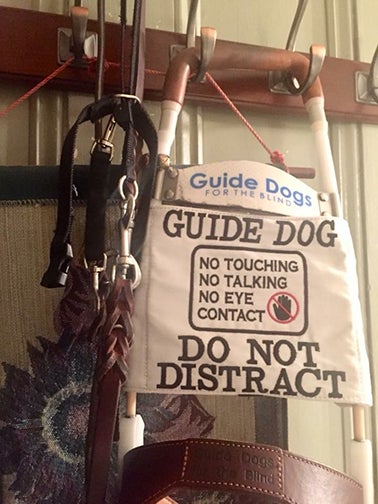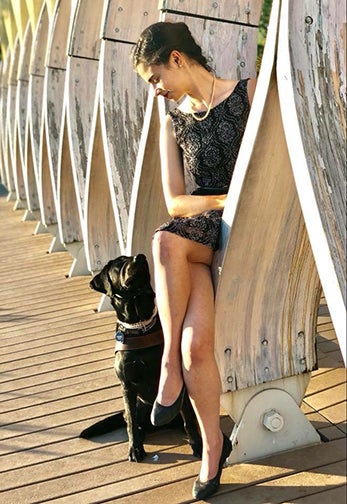KINGSTON, R.I.- September 10, 2018- Your first few days at the University of Rhode Island can be filled with cool opportunities, making new friends, going to the beach, or catching a soccer or football game. You may also see a friendly looking dog on a leash walking across campus with his human friend. You’re eager to say hello because it reminds you of your four-legged best friend at home.
But, before you begin calling to the dog, consider this: your eagerness for this particular canine encounter could be a matter of life or death for its handler who relies on the eyes of that dog.
Ingrid is one of those well-known dogs on the Kingston Campus, and she serves as a set of guiding eyes for Aria Mia Loberti, a junior at URI who is legally blind and relies on the Labrador retriever to negotiate her busy class schedule and extra-curricular activities. So the best rule of thumb for those who want to greet Ingrid is to ask Loberti first.
Don’t reach out to pet Ingrid. Don’t talk to her because Ingrid is on the job for Loberti.
A triple major in philosophy, communications and political science, youth delegate to the United Nations and mentor to other students, Loberti relies on Ingrid to navigate every inch of URI’s Kingston campus. From classes in Swan Hall to the biology lab in Woodward Hall, there is little time to stop along the way to introduce Ingrid to her admirers.

“Guide dogs are in charge of a life,” explained Loberti. “These animals assist their handlers with a disability by executing responsibilities that a handler cannot. Ingrid is my eyes, and when she stops working because she is distracted or frightened, I am forced to stop and determine the source of the distraction, and work with Ingrid to get her focus back. Often, distractions like people trying to get Ingrid’s attention are avoidable, all it takes is awareness and education, but these can threaten both of our safety. Feel free to ask me questions and address me, but follow the instructions on Ingrid’s harness sign: ‘Do Not Distract.’”
During fall 2017, Loberti wrote an original piece of research on Guide Dog/Handler communication and perception and presented her work at the Western States Communication Association Conference in California in February of 2018.
“The paper elaborated on methods through which guide dog teams (humans and dogs) communicate verbally and nonverbally; discussed the changed self-perception of a person who is blind before and after receiving their guides; and elucidated means through which the general public’s perception of the person who is blind changed in the presence (or absence) of a guide dog,” explained Loberti, who hopes the paper might get published or selected for a chapter in a book in the future.
Her research, while still ongoing, supports the premise that handlers feel more accepted by the general public when they rely on a guide dog instead of a white cane.
“A white cane can be a communicative barrier,” said Loberti. “It is important to see disability as a part of culture and to diminish stigma in general. A dog is a great way to open that door.”
Ingrid has an exceptional understanding of both basic and complicated commands to pair with her understanding of 75 words, Loberti said. Her task is to guide Loberti around obstacles, both on the ground and overhead, while identifying spaces and places that Loberti frequents to keep the URI student safe.
“By the second week of a semester, our routine is well established and Ingrid knows where I need to be and when,” said the Johnston resident. “She knows the routes I use and sometimes knows where I need to be based on the day of the week even if I might space out for a second.”
But you won’t see Ingrid basking in the affection of students or scrounging for food. She is trained to refuse food, so if you drop your sandwich while rushing to class or put a savory treat right in front of her face, she won’t eat it.
Much of the communication between Loberti and Ingrid is from the feedback of the harness or leash. A gentle leader, a thin head collar that attaches to the leash and the neck collar, allows Loberti to feel the dog’s gestures and actions.
“I’m not positive if this is a guide dog thing or just an Ingrid thing,” said Loberti. “But, if someone comes from behind me and pets Ingrid, she physically jams herself into me so I can identify the distraction. She knows how to alert me with her whole body.”
The difference between guide dogs or other service animals and emotional support animals is simple. Loberti said the latter are not responsible for performing tasks to mitigate or compensate for a handler’s disability, instead they provide comfort and support simply by being present. Emotional support animals do not have public access rights like guide or service dogs. But emotional support animals are allowed on plane flights and in various forms of housing. Guide dogs and other service animals, however, must go everywhere their handler does.”
Service and guide dogs are protected under the United States Department of Justice through the Americans With Disabilities Act of 1990. Refusing service or entrance to a person because of their guide/service dog is illegal. It is also illegal to ask a guide/service dog handler for their dog’s identification or for proof of a disability.
“Once the line between service animals and emotional support animals is blurred, public spaces could become flooded with dogs who are not properly trained, leading to a slew of other problems,” explained Loberti.
Part of what sets Ingrid apart from her canine colleagues is the years of extensive training she underwent before being paired with Loberti.
“Ingrid’s family consists of generations of dogs who were bred to guide humans,” said Loberti. “During training, these dogs are exposed to countless scenarios and environments that prepare them for the experiences they will have in the real world. Between 13 and 15 months old, the dogs are put in their harness, the training only intensifies with more frequent tests.
Upon completion of Ingrid’s training, Loberti, her lifestyle and even the URI campus were assessed to ensure that the two were a perfect match before anything was set in stone.
“Dogs that were bred and trained to guide can still be cut from the program if they are not the right temperament or if they cannot catch on,” Loberti explained. “More than 250 people are involved in the training of one dog and the breeding, raising, training, equipment and lifetime care for a guide dog can cost thousands, and in some cases, up to a quarter of a million dollars. When you consider all of the money and time that goes into making a guide dog as exceptional as Ingrid, it is staggering to consider that someone repeatedly petting her or blocking her path can break her career.”
So what do you do when you see Ingrid or another guide dog patrolling the campus?
“Never address the dog directly or enter her space without asking,” said Loberti. “When I am not in a rush, I welcome people who want to ask questions. It is even alright to ask if you may pet Ingrid, but to please not be offended if I say no. Ingrid is taught that when her harness is on, she is working and working only for me. For her to be pet, I have to take the harness off, which means I have to be in a safe space. Other than that, it is important that people communicate with Ingrid through me. While Ingrid is of course a dog, she is also a working piece of medical equipment. She is like a white cane or a pair of glasses, so would you come up and start petting either of those?
“Extending a hand directly to the dog poses an obstacle that she will work to get around,” said Loberti. “Generally, just use your best judgement when it comes to approaching or not approaching a guide dog and their handler, keeping in mind that when a dog is in their harness, they are working.”
Olivia Ross, an intern in the Marketing and Communications Department at URI and public relations major, wrote this press release.

